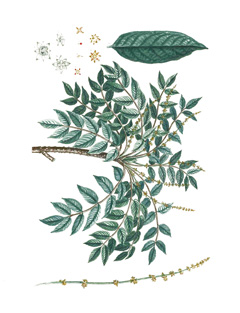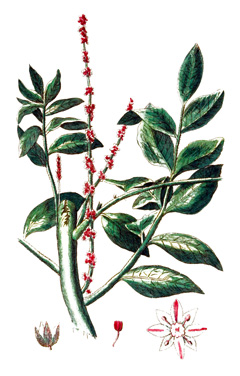 |
|
https://edibleplants.org/ |
 |
| https://edibleplants.org/ |
Translate this page:
Summary
Found in tropical Africa, Brucea antidysentericais a monoecious shrub or small tree commonly used in traditional medicine as treatment for dysentry. It grows up to around 7 m high. The bark is grey, the leaves are alternate, and the flowers are green and very small. The bitter fruits reportedly have toxic effects on livestock especially sheep. The bark, fruit, and roots are also used as an anthelmintic and to relieve fever. It is also used against diarrhoea, ingestion, asthma, and stomach pain. Ointments can be made from the leaves and twigs along with ghee or butter to treat wounds and skin ailments. Roots are used for rabies and sores caused by sexually transmitted diseases. The bark is used as a bitter flavouring.
Physical Characteristics

 Brucea antidysenterica is an evergreen Tree growing to 7 m (23ft) by 7 m (23ft) at a medium rate.
Brucea antidysenterica is an evergreen Tree growing to 7 m (23ft) by 7 m (23ft) at a medium rate.
See above for USDA hardiness. It is hardy to UK zone 10.
Suitable for: light (sandy), medium (loamy) and heavy (clay) soils. Suitable pH: mildly acid, neutral and basic (mildly alkaline) soils. It can grow in full shade (deep woodland) semi-shade (light woodland) or no shade. It prefers moist soil.
UK Hardiness Map
US Hardiness Map
Synonyms
Brucea abyssinica Spreng. Brucea ferruginea L'H?r. Brucea salutaris A.Chev.
Plant Habitats
Edible Uses
Edible Parts: Inner bark
Edible Uses: Condiment
Edible portion: Bark - spice. The bark is used as a bitter flavouring.
References More on Edible Uses
Medicinal Uses
Plants For A Future can not take any responsibility for any adverse effects from the use of plants. Always seek advice from a professional before using a plant medicinally.
Anthelmintic Antiasthmatic Antibacterial Antidiarrhoeal Antitumor Cancer Dysentery Febrifuge
Leprosy Malaria Skin
As its name suggests, the plant is of value in traditional medicine for the treatment of dysentery. Modern research has confirmed this action and also highlighted other potential uses of the plant. The leaves and stem bark contain quanninoids and canthin alkaloids that have potent anticancer properties, and these have attracted much research attention in recent decades[ 299 ]. Some trials have been inconclusive, whilst others have shown promising results, especially since the effects were facilitated in the absence of overt toxicity[ 299 ]. In addition to their antineoplastic activity, many compounds present in the plant are highly effective against the dysentery-causing amoeba, Entamoeba histolytica, and the malaria parasite Plasmodium falciparum[ 299 ]. Quassinoids from the plant have exhibited weak anti-tuberculosis activity in vitro, whilst their anti-HIV potential is marred by high cytotoxicity[ 299 ]. Quassinoids are characteristic of the Simaroubaceae; they give the bark of Brucea antidysenterica a distinctive bitter taste[ 299 ]. Canthin alkaloids, present in the root bark of Brucea antidysenterica, have anticancer and antimicrobial properties[ 299 ]. The bark, fruit and roots are widely used against dysentery, as an anthelmintic and to treat fever[ 299 ]. The bark, fruit, seeds, leaves and roots (sometimes boiled) are used as a remedy for diarrhoea, indigestion and stomach-ache[ 299 ]. The leaves and roots are cooked with meat, or infused with milk (for children) to relieve asthma[ 299 ]. Wounds and skin complaints, such as those caused by leprosy and scrofula, are treated with ointments made from the leaves and twigs mixed with ghee or butter, or from the ripe fruits mixed with honey[ 299 ]. Preparations of the roots are used on sores caused by sexually transmitted diseases, while the leaves and seeds are used to treat cancerous skin tumours[ 299 ]. The roots are used to treat rabies[ 299 ].
References More on Medicinal Uses
The Bookshop: Edible Plant Books
Our Latest books on Perennial Plants For Food Forests and Permaculture Gardens in paperback or digital formats.

Edible Tropical Plants
Food Forest Plants for Hotter Conditions: 250+ Plants For Tropical Food Forests & Permaculture Gardens.
More

Edible Temperate Plants
Plants for Your Food Forest: 500 Plants for Temperate Food Forests & Permaculture Gardens.
More

More Books
PFAF have eight books available in paperback and digital formats. Browse the shop for more information.
Shop Now
Other Uses
Dye Fuel Roofing
Other uses rating: Low (1/5). Other Uses: The fruit contains about 22% oil[ 299 ]. No uses are mentioned[ K ]. A yellow dye in the fruit endocarp is non-soluble in water[ 299 ]. The wood is used as firewood and for roof construction[ 299 ].
Special Uses
References More on Other Uses
Cultivation details
The plant grows at moderate elevations, usually to 2,500 metres but exceptionally to 3,700 metres in the moister tropics of Africa[ 299 ]. Vegetative growth, flowering and fruiting continue throughout the year, even in the dry season[ 299 ]. Brucea antidysenterica has been recorded as a host plant of the Mediterranean fruit fly, a major pest of the fruit industry[ 299 ].
References Carbon Farming Information and Carbon Sequestration Information
Temperature Converter
Type a value in the Celsius field to convert the value to Fahrenheit:
Fahrenheit:
The PFAF Bookshop
Plants For A Future have a number of books available in paperback and digital form. Book titles include Edible Plants, Edible Perennials, Edible Trees,Edible Shrubs, Woodland Gardening, and Temperate Food Forest Plants. Our new book is Food Forest Plants For Hotter Conditions (Tropical and Sub-Tropical).
Shop Now
Plant Propagation
Seed - best sown in situ. Readily propagated from seed, an alternative method of propagation is transplanting wildlings[ 299 ]. Seed can be stored at room temperature for over a year[ 299 ].
Other Names
If available other names are mentioned here
Waginos or Brucea antidysentericais
Native Range
Coming Soon
Weed Potential
Right plant wrong place. We are currently updating this section.
Please note that a plant may be invasive in one area but may not in your area so it's worth checking.
None Known
Conservation Status
IUCN Red List of Threatened Plants Status : This taxon has not yet been assessed.

Growth: S = slow M = medium F = fast. Soil: L = light (sandy) M = medium H = heavy (clay). pH: A = acid N = neutral B = basic (alkaline). Shade: F = full shade S = semi-shade N = no shade. Moisture: D = dry M = Moist We = wet Wa = water.
Now available:
Food Forest Plants for Mediterranean Conditions
350+ Perennial Plants For Mediterranean and Drier Food Forests and Permaculture Gardens.
[Paperback and eBook]
This is the third in Plants For A Future's series of plant guides for food forests tailored to
specific climate zones. Following volumes on temperate and tropical ecosystems, this book focuses
on species suited to Mediterranean conditions—regions with hot, dry summers and cool, wet winters,
often facing the added challenge of climate change.
Read More
Expert comment
Author
J.F.Mill.
Botanical References
Links / References
For a list of references used on this page please go here
A special thanks to Ken Fern for some of the information used on this page.
Readers comment
| Add a comment |
|
If you have important information about this plant that may help other users please add a comment or link below. Only comments or links that are felt to be directly relevant to a plant will be included. If you think a comment/link or information contained on this page is inaccurate or misleading we would welcome your feedback at [email protected]. If you have questions about a plant please use the Forum on this website as we do not have the resources to answer questions ourselves.
* Please note: the comments by website users are not necessarily those held by PFAF and may give misleading or inaccurate information.
To leave a comment please Register or login here All comments need to be approved so will not appear immediately.
|
Subject : Brucea antidysenterica
|
|
|
|